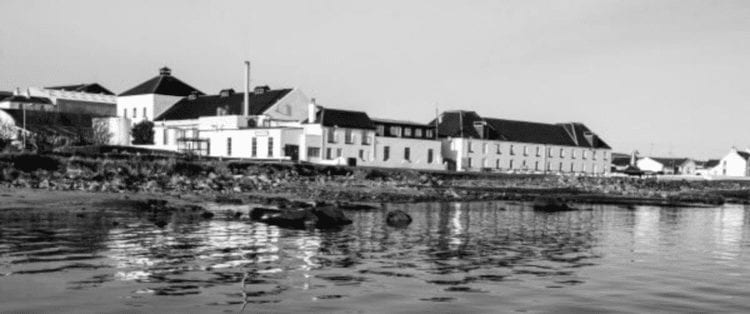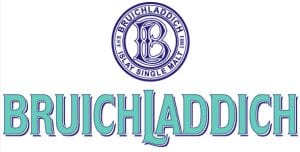Bruichladdich Distillery Information
The Bruichladdich distillery was established by the Harvey Brothers (William, John and Robert)in 1881 on the north side of Loch Indaal on the isle of Islay. It was the most western distillery in Scotland until 2005, when that title was passed on to the nearby Kilchoman distillery (since then, Abhainn Dearg took over that title in 2007). The Harvey family owned two distilleries in Glasgow (Yoker and Dundas Hill), and the brothers figured the time was right to start one of their own. The distillery itself was designed by John, engineered by Robert, and financed by William and other family members. At the time of construction, it broke tradition with the existing Islay farm distilleries, by using an efficient design with the distillery buildings around a spacious courtyard. It also employed techniques that were considered high-tech at the time (it was one of the first distilleries using concrete for construction), and was the first distillery to use anti-collapse valves; nowadays a standard piece of equipment in every distillery. The name is derived from Gaelic, and translates into “brae by the shore”.

The Bruichladdich distillery remained under ownership of the Harvey family (though there was a major falling out with the investors, leading to a temporary closure from 1907 until 1919), ran by William, until 1929, when the global crisis forced it to shut down. In 1937, William passed away, and the distillery was sold off to a Joe Hobbs, who promptly resold it to Ross & Coulter Ltd; a company in which he had an interest. In 1952, they sold it to Ross and Coulter Ltd, whisky brokers from Glasgow. In 1960, the distillery was bought by AB Grant. 8 years later, in 1968, it once again changed hands; this time to Invergordon Distillers, who doubled the amount of stills in 1975. In October 1933, Jim Beam Brands (JBB) in the name of their recently acquired Whyte and Mackay took over Invergordon, decided 2 months later that Bruichladdich was redundant for their business, and thus shut the distillery.
Luckily, a group of private investors led by wine merchant Mark Reynier bought the Bruichladdich distillery in late December 2000 using the name of Bruichladdich Distillery Co. Ltd. Under their guidance, the distillery was reopened, and established itself as a new and fresh brand. In 2012, Remy Cointreau took over ownership of the distillery.

Nowadays, the distillery still has the exact same layout as when it was first constructed, and most of the original machinery is still in use. The wash still, for instance, has been repaired, rather than replaced, and is the same still that was fitted in 1881. Likewise, the mash tun recently was repaired, and rather than replacing the cast iron parts with newer stainless steel, the parts were recreated in cast iron, in order to preserve the traditional setup.
Bruichladdich whisky
The whisky produced at Bruichladdich is unlike other Islay whisky in that the spirit to be sold as Bruichladdich is using unpeated (or very low peated) Barley. However, the distillery also made a point out of producing peated whisky, albeit under different names (Port Charlotte and Octomore). The distillery aims at using as much organic materials as possible, and as stated above, it’s using the old Victorian-era equipment, with barely a computer or other piece of technology present in the distillery.
Core range (100% Scottish barley):
- The Classic Laddie; made using 100% Scottish barley, trickle distilled, and matured in American oak.
- Port Charlotte; peated to 40ppm.
- Octomore; peated at 167 ppm, this truly deserves the title of “the world’s most heavily peated whisky”.
100% Islay barley:
- Islay Barley 2007; distilled from barley grown in the Minister’s Field at Rockside Farm, slowly distilled.
- Port Charlotte Islay Barley; not yet released.
- Octomore 06.3 Islay Barley; not yet released.
Organic barley:
- The organic Scottish Barley; created using 100% Scottish organic barley, matured in American oak.
- Bere barley 2006; using Bere barley (one of the oldest strains of Barley to be used domestically), the barley for this whisky was sown in non-chemically treated soil that had been unused for over 100 years.
Cask Exploration:
- Black Art 4; matured in French and American oak, mixed in an unknown combination.
- Octomore 06.2; heavily peated, and matured in Limousin oak from Acquitaine.
Time exploration:
- Port Charlotte PC11; heavily peated, and matured for 11 years. Created from Scottish barley.
Distillery info:
| Name | Bruichladdich |
| Region | Islay |
| Logo |  |
| Status | Active |
| Founded | 1881 |
| Water source | An Torran Loch, The Bruichladdich burn, Octomore spring |
| Owned by | Rémy Cointreau |
| Address |
Bruichladdich Distillery Isle of Islay Argyll, +44 (0)1496 850 190 |
| Visitor centre | Yes |
| Website | http://www.bruichladdich.com/ |
| http://www.twitter.com/bruichladdich | |
| http://www.facebook.com/bruichladdich | |
| Community | N/A |
| Map |
Distillery Setup:
Component |
Capacity |
Quantity |
|---|---|---|
| Mash tun | 7 tonnes | 1 (open top) |
| Washback | 35,000 / 40,000 litres | (Douglas Fir) |
| Wash still | 17,300 litres | 2 |
| Spirit Still | 12,274 litres | 2 |
| Expected yearly output in LPA (Litres of pure alcohol) | 1,500,000 |
Images courtesy of the Bruichladdich distillery
